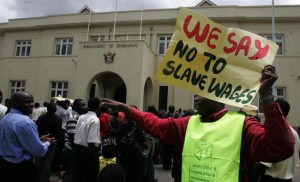Justice John Paul Stevens (Photo by Chip Somodevilla/Getty Images)
When I got to law school, I thought John Paul Stevens was a “liberal.” That’s what I had been told. When the Supreme Court’s decision in Bush v. Gore came down in the fall of my 1L year, Stevens’s scathing dissent from that opinion seemed to confirm what I had been led to believe. Stevens wasn’t just a liberal but a “lion,” the leader of the progressive wing of the Supreme Court.
Learning that I was wrong is one of the ways I mark the difference between a layperson’s understanding of the law, and a lawyer’s understanding of the law. Yes, Stevens ended up as a reliable progressive vote, but that’s not because he was a progressive ideologue. It was because Republicans were successful in nominating conservative ideologues and the Court lurched rightward under Stevens’s feet. As Ian Millhiser put it on ThinkProgress:
Stevens stood still, while the Supreme Court’s center of gravity lurched to the right. “The Court has changed significantly,” Stevens wrote in 2006. “It was then more faithful to Brown and more respectful of our precedent than it is today. It is my firm conviction that no Member of the Court that I joined in 1975 would have agreed with today’s decision.”
The decision was Parents Involved v. Seattle School District No. 1, which held that two public school districts violated the Constitution by implementing plans to desegregate their schools.
That case, Parents Involved, is the case where, writing for the majority, Chief Justice John Roberts unleashed his famous line: “The way to stop discrimination on the basis of race is to stop discriminating on the basis of race.” Stevens, a Gerald Ford appointee, dissented from the opinion modern conservatives now think embodies a center-right perspective on race. Conservative judicial appointments have adopted such clearly anti-Brown (both literally and figuratively) policies that John Paul Stevens seemed liberal to them by the end.
Which is why we’ll never see judges like Justice Stevens again on the Supreme Court. Movement conservatives, led as they are now by the Federalist Society, have long abandoned the kind of judicial restraint and commitment to precedent practiced by “conservatives” like John Paul Stevens. Conservatives don’t like the precedents that say minorities are entitled to equality under the law, women are entitled to control over their own bodies, and gays and lesbians are entitled to love who they wish. It’s no longer “conservative” to be “restrained.” Now, conservatives want the unrestrained. They want the aggressive rollback of regulations, rights, and progress.
Over on Facebook, UCLA Law Professor Jonathan Zasloff wrote that he didn’t always agree with Justice Stevens. That was a feature of his jurisprudence, not a bug:
Perhaps [Stevens] didn’t have an overarching Theory Of Everything that he could apply formalistically and uncontroversially downward. What you knew, if you had a good case that honestly was trying to apply precedents, was that it was damn good to see him up there on the bench, that you would get a judge who would understand what was happening and wasn’t just going to ram through the latest fancy theory because it was the latest fancy theory.
He was a judge. And a damn good one.
Conservatives do not want judges who will apply their best guess at the law. They want judges who will impose their pet theories about the law upon cases and controversies. It is sad that a person like Justice Stevens, who couldn’t be pegged down before the brief was even filed, could no longer become a Supreme Court Justice for a Republican administration.
But the saddest thing of all is that, order to meet the radicalized threat posed by the kind of judges modern conservatives appoint, progressives had better start acting the same way. The Court has lurched right, if you want to drag it back to the center, Democrats need to start appointing hardcore progressives. Standing on the center of the see-saw does nothing to balance it out when there’s an elephant squatting on one end.
Republicans understand this, but I’m not sure liberals do. Even if Democrats retake political power in the White House and the Senate, I’m not sure they’re ready to do what is necessary.
Barack Obama surely was not. In many ways, Elena Kagan, who Obama appointed to replace John Paul Stevens on the Supreme Court, is a justice fully in keeping with the Justice Stevens style of conservative legal judgment that only looks “leftist” when plotted against the radicalization of the conservative movement. Kagan is no progressive firebrand. She’s no ideologue. She’s a precedent-loving centrist who stands against the conservative attempt to ignore precedent that disagrees with their pet theories. Had Obama succeeded in getting Merrick Garland on the Court, he likely would have ruled in much the same way as Kagan and Stevens before her. Compared to Neil Gorsuch, sure, Garland is “progressive.” Compared to, I don’t know, Vanita Gupta, Garland is a problem.
Only Justice Sonia Sotomayor stands out among Obama Supreme Court appointees as a true progressive, but she’s very much grown into that role. She didn’t necessarily look like she’d be the strong advocate of criminal justice reform that she’s turned out to be, when she was appointed by George H.W. Bush to the district court. She didn’t look like she’d be who y’all think Ruth Bader Ginsburg is when she was picked off the Second Circuit by Barack Obama. Progressives got lucky with Sotomayor.
The fact that the Democrats running for president have not told me what kind of nominees they will make for the courts is worrisome. The odious Judicial Crisis Network is already running ads, “warning” people that the Democrats have a “secret list” of ultra-liberal nominees, and the Democrats aren’t responding, “HELL YES, WE DO! In fact, HERE’S THE LIST of the awesome people we’re going to appoint to try to STOP YOU.” I don’t hear Larry Krasner’s name being talked about for a Supreme Court appointment, I don’t hear the promises to bring back Goodwin Liu, and I don’t hear Gupta being floated as the next justice. Instead, I hear people talking about rolling Merrick Garland (now 66 years old) back out there for another round.
John Paul Stevens was a model of what a Supreme Court justice should be. But now his watch has ended. We will never see his like again. We can’t hide behind the legal wall of precedent that people like Justice Stevens built for us. It’s time to send in some fire-breathing liberals and stealthy legal assassins.
Elie Mystal is the Executive Editor of Above the Law and a contributor at The Nation. He can be reached @ElieNYC on Twitter, or at elie@abovethelaw.com. He will resist.








 Scott Alan Burroughs, Esq. practices with
Scott Alan Burroughs, Esq. practices with 










